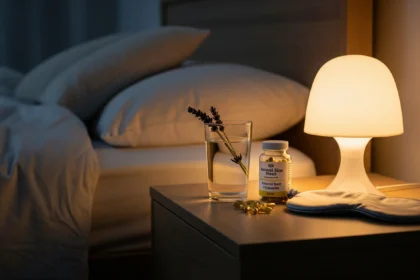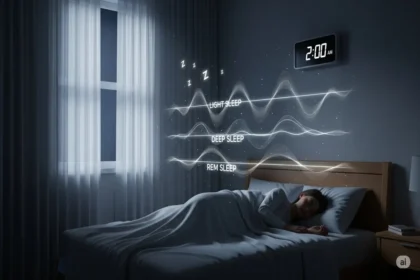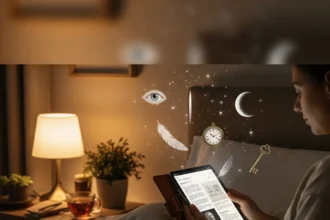Oh, the sweet promise of sleep! We chase it, we yearn for it, and often, we find ourselves tossing and turning, frustrated by its elusive nature. We meticulously plan our diets, track our steps, and meditate to calm our minds, all in pursuit of that elusive, restorative slumber. Yet, we often overlook one of the most fundamental aspects of a good night’s rest: the very space where we lay our heads. Our bedrooms, far too often, are reflections of our busy lives – cluttered, brightly lit, and perhaps, unknowingly, sabotaging our sleep. But what if transforming your bedroom into a dedicated haven could be among the most impactful essential bedroom enhancements for deeper sleep you could ever make?
Imagine walking into a space that instantly signals calm, peace, and an invitation to truly unwind. Not just a place where you happen to sleep, but a sanctuary designed with the sole purpose of fostering profound rest. This isn’t about expensive renovations or a complete overhaul; it’s about understanding the subtle yet powerful ways our environment influences our biology, and then making thoughtful adjustments.
The Science of Serenity: Why Your Bedroom Matters More Than You Think
Our brains are remarkably sensitive to cues from our environment. When it comes to sleep, two primary senses – sight and sound – play starring roles, closely followed by touch and temperature. Think of it as a subtle conversation between your surroundings and your central nervous system. A brightly lit room, even with indirect light, can suppress melatonin production, the hormone crucial for signaling to your body that it’s time to wind down. Similarly, an overly warm room can disrupt your body’s natural temperature regulation, making it harder to fall and stay asleep.
Dr. Matthew Walker, a renowned sleep scientist and author of “Why We Sleep,” often emphasizes the critical role of environment. He posits that our modern bedrooms, frequently doubling as home offices, entertainment hubs, or even informal dining areas, send mixed signals to our brains. Our ancient ancestors associated their sleeping spaces with safety and darkness, an innate prompt for rest. Today, many of us perform stimulating activities in the very room we expect to surrender to slumber. This cognitive dissonance can make falling asleep a challenge, even when we’re physically exhausted.
Consider Maria, a freelance writer who, for years, worked from her bed, laptop perched on her knees. Her bedroom was a lively space, filled with books, creative projects, and the occasional spilled coffee cup. She struggled with insomnia, often finding her mind racing with work-related thoughts long after she’d closed her laptop. It wasn’t until a friend, a sleep coach, suggested creating a distinct boundary between her workspace and her sleep space that things began to shift. Maria moved her desk to a corner of her living room, and consciously began to keep her bedroom exclusively for rest. The simple act of entering her bedroom now triggered a different mental response, a sense of winding down rather than gearing up.
The Pillars of a Sleep Sanctuary: Simple Yet Profound Changes
Creating your sleep sanctuary is a multi-sensory endeavor, touching upon light, sound, temperature, and even the tactile experience of your bedding. Each element, no matter how small, contributes to the overall symphony of rest.
1. The Power of Darkness: Banish the Light Invaders
This is arguably the most crucial enhancement. Even a sliver of light from a streetlamp, a charging phone, or an alarm clock can be enough to disrupt your sleep. Light, especially blue light (the kind emitted by screens), actively suppresses melatonin production.
- Blackout Curtains/Blinds: This is non-negotiable for serious sleep seekers. Invest in thick, opaque curtains or blinds that block out all external light. Ensure they extend beyond the window frame to prevent light leakage.
- Cover All LEDs: Those tiny, innocuous red or green lights from charging devices, smoke detectors, or power strips? They add up. Use electrical tape, small pieces of cloth, or even nail polish to cover them.
- Say No to Nightlights & Gadgets: Avoid nightlights in your bedroom. If you need to navigate in the dark, use a red-light flashlight (red light has the least impact on melatonin). Move all electronic devices out of the bedroom, or at least ensure they are powered off and stored away from your bed. If your phone is your alarm, place it face down or in a drawer.
Think about a cave – completely dark. Your brain, in its ancient wisdom, associates darkness with sleep. Recreating this primal darkness tells your body it’s safe to power down.
2. The Hush of Silence: Mute the World
Noise, even if you consciously don’t “hear” it, can fragment your sleep, pulling you out of deeper stages. Our brains continue to process sounds even when we’re asleep, triggering alerting responses.
- Soundproofing (Simple Steps): While full soundproofing might be impractical, you can make significant improvements. Seal gaps around windows and doors with weather stripping. Arrange furniture strategically against shared walls.
- White Noise/Pink Noise Machines: These are invaluable tools for masking unpredictable external noises like traffic, noisy neighbors, or even internal household sounds. White noise contains all frequencies at equal intensity, creating a gentle “shhh.” Pink noise, often found in nature sounds like rainfall or rustling leaves, has lower frequencies, making it sound “softer” and more soothing to some.
- Earplugs: A simple, inexpensive solution that can be incredibly effective, especially for light sleepers or those in noisy environments. Experiment with different types to find the most comfortable fit.
The goal isn’t absolute silence, which can sometimes make minor sounds more jarring, but rather a consistent, calming sonic environment.
3. The Goldilocks Zone: Temperature Control
Your body temperature naturally dips as you prepare for sleep and remains lower throughout the night. An overly warm room prevents this natural cooling, making it difficult to initiate and maintain sleep.
- Ideal Temperature: Most sleep experts recommend a bedroom temperature between 18-20°C (65-68°F). This might feel cool when you first get into bed, but it’s optimal for regulating your internal body temperature for sleep.
- Smart Thermostats/Fans/AC: Invest in a programmable thermostat if you don’t have one, allowing your room to cool down before bedtime. A fan can also be effective, not only for cooling but also for providing gentle white noise.
- Breathable Bedding: Opt for natural, breathable fabrics like cotton, linen, or bamboo for your sheets, blankets, and pajamas. These materials wick away moisture and help regulate temperature more effectively than synthetic alternatives.
Think of it as creating a cool, subterranean den – the perfect environment for hibernation.
4. The Tactile Comfort: Bedding and Mattress
Your mattress and pillows are the foundation of your sleep experience. They provide the support and comfort your body needs to fully relax and recover.
- Mattress Matters: A good mattress supports your spine in a neutral alignment, alleviating pressure points. If you wake up with aches and pains, or if your mattress is over 7-10 years old, it might be time for an upgrade. Don’t be afraid to test mattresses extensively; it’s a significant investment in your health.
- Pillow Perfection: Your pillow should support your head and neck, maintaining spinal alignment whether you’re a back, side, or stomach sleeper. Side sleepers often need a thicker pillow, while back sleepers might prefer a medium loft. Stomach sleepers typically need a very thin or no pillow at all.
- Luxurious Linens: While not strictly necessary, high-quality, comfortable bedding can enhance the sensory experience of your sleep sanctuary. Soft, natural fabrics feel inviting and contribute to a sense of comfort and luxury.
This is where you physically surrender to sleep, so ensuring maximum comfort is paramount.
5. The Zen Zone: Declutter and Decorate with Purpose
Your bedroom should evoke peace, not stress. Clutter is a visual representation of unfinished tasks and mental “noise.”
- Declutter Ruthlessly: Remove anything that doesn’t contribute to relaxation or sleep. This includes work documents, laundry piles, exercise equipment, or general “stuff.” A clean, organized room promotes a clear, organized mind.
- Soothing Colors: Opt for calming, muted colors on your walls and in your decor – blues, greens, greys, or soft neutrals. These colors are known to have a tranquilizing effect.
- Minimalist Approach: Avoid excessive ornamentation or busy patterns. Simplicity fosters serenity.
- Aromatherapy (Optional): Essential oil diffusers with calming scents like lavender, chamomile, or cedarwood can add another layer of relaxation. Ensure the scent is subtle and not overpowering.
- No Electronics (Seriously!): Reinforce the idea that your bedroom is for sleep and intimacy only. Charge your phone in another room. Keep the TV out. Even e-readers can emit blue light, so opt for a physical book or a device with an e-ink screen if you must read in bed.
Remember Mark, a high-flying executive who found himself waking up at 3 AM consistently. His bedroom, while stylish, was adorned with framed work awards, a large flat-screen TV, and his laptop always sat open on a side table. He realized his sleep space was a constant reminder of his demanding career. After decluttering, removing the TV, and relocating his awards to his office, he found his sleep patterns gradually improved. His bedroom truly became a space of respite, not a second office or an extension of his busy life.
The Unspoken Invitation: A Place of Rest and Rejuvenation
Creating your sleep sanctuary isn’t a one-time project; it’s an ongoing commitment to prioritizing your well-being. It’s about designing a personal retreat, a place where the stresses of the day melt away, and your body and mind feel safe to surrender to the deep, restorative embrace of sleep.
Think of your bedroom not just as a room, but as an invitation. An invitation to disconnect from the digital world, to shed the burdens of the day, and to truly rest. When you walk into a space that is cool, dark, quiet, and comfortable, your body inherently understands the cue. It’s a powerful, non-verbal message: “This is where you heal. This is where you recharge. This is where you sleep.”
So, take a thoughtful look at your bedroom tonight. What message is it sending to your brain? Is it a chaotic hub of activity, or a tranquil haven designed for the most fundamental human need – truly restorative sleep? By investing a little time and intention into these essential bedroom enhancements, you’re not just redecorating; you’re reclaiming your right to profound, uninterrupted rest, and ultimately, a more vibrant, energized life.
Disclaimer: The information provided in this article is for general informational purposes only and does not constitute medical advice. It is not a substitute for professional medical advice, diagnosis, or treatment. Always seek the advice of your physician or other qualified health provider with any questions you may have regarding a medical condition. Never disregard professional medical advice or delay in seeking it because of something you have read on this website.














